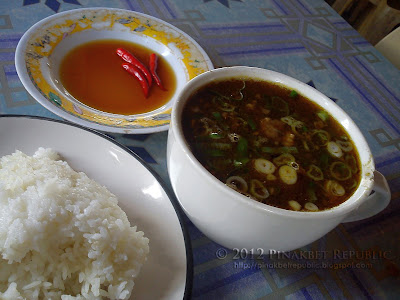 |
| Beef imbaliktad with soup. |
Right, it's imbaliktad. And yes, it is, and it has, soup. Imbaliktad is usually dry--beef (or carabeef, or goat) tender loin, innards, tripe, cut into strips and sautéed in garlic, onions, ginger, peppercorns and then stir-fried briefly and quickly, pour in some pespes/pinespes ("intestine juice") for it's truly Ilokano bitter flavor, stir it a few times more, and it's done. The meat should be tender, rare or medium rare, not tough, not overly done.
But it's equally good with a broth or soup, just like pinapaitan. The difference would be, that pinapaitan is cooked longer to soften/tenderize the meat and innards. Imbaliktad as it name implies is a quick fix, just a few stirring of the meat and innards in high heat to let the spices seep in in its raw meat sweet succulence. Imbaliktad with soup is, well, with soup, and it's done when its broth has boiled or bubbled in the process called "pers burek" (the time the boiling broth/soup has bubbled). Upon bubbling, it's done.
Let's do it. First off, cut the meat and innards into strips or bite size:
In a pan or a wok, sauté the garlic, onions and ginger in oil:
Then pour in the pespes:
Stir and simmer. Sautéing the pespes with the spices will make great flavor and aroma of the imbaliktad truly and uniquely the Ilokano way:
Add in water for the soup:
Boil and simmer:
Now, in the boiling broth, add in the meat and innards:
Stir, stir, stir until it boils and bubbles. This is the "pers burek." It's done. Put off fire:
But with soup, see that golden soup, bitter but sweetish, and insanely fragrant:
Burp!
:::::




































































